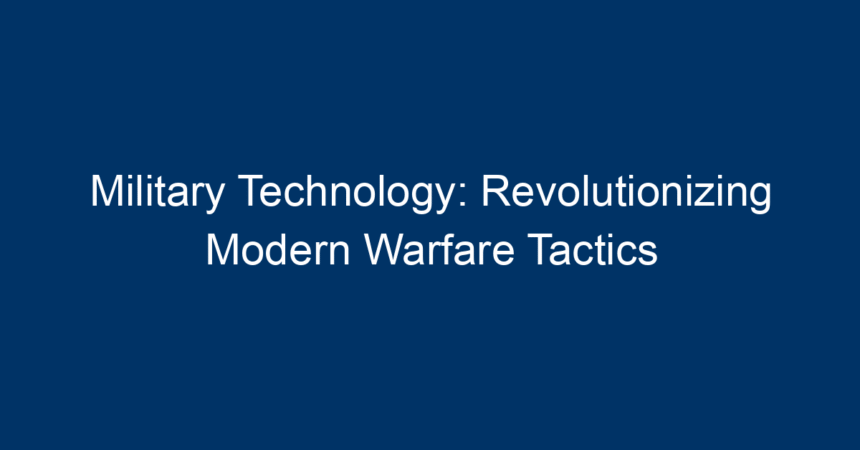Introduction
In the rapidly evolving realm of warfare, the phrase “military technology” evokes a sense of both awe and urgency. From the rise of drones to advanced cyber capabilities, the innovations defining modern military engagements are not just reshaping the battlefield; they are also transforming strategies, tactics, and even the ethics of warfare. As nations invest heavily in cutting-edge technology to gain strategic advantages, understanding the implications of these developments is crucial for military strategists, policymakers, and even civilians.
This article delves into how military technology is revolutionizing modern warfare tactics, exploring key innovations, their impacts, and the future landscape of conflict.
The Shift in Warfare Dynamics
The Role of Advanced Robotics
Robotics has taken center stage in military technology, fundamentally altering how conflicts are approached. Unmanned Aerial Vehicles (UAVs), commonly known as drones, allow for reconnaissance missions that reduce human risk. Notably, their precision strike capabilities enable targeted attacks with minimal collateral damage, a tactical advantage in urban warfare scenarios.
The growing reliance on robotic soldiers and ground vehicles is paving the way for remote warfare tactics. Countries are adapting their strategies as they leverage these technologies for intelligence gathering, surveillance, and combat.
Cyber Warfare: The New Frontier
Cyber capabilities are redefining conflict, where military technology goes beyond the physical battlefield. Nations are developing robust cyber defenses and offensive capabilities to disrupt enemy communications and infrastructure.
The 2020 SolarWinds cyberattack highlights how vulnerable countries can become, showcasing that successful attacks can lead to strategic paralysis without a single shot being fired. Military planners are now prioritizing cyber warfare as a crucial component of national defense strategies.
Artificial Intelligence in Combat
Artificial Intelligence (AI) is another game-changer in military technology. By analyzing vast amounts of data rapidly, AI enhances decision-making processes. For instance, AI algorithms can identify patterns in enemy movements, helping strategists anticipate actions and responses.
AI-powered drones and autonomous vehicles are becoming increasingly capable, often integrating with traditional military assets to create hybrid strategies tat expand operational capabilities. As these technologies evolve, ethical debates surrounding autonomy in warfare and decision-making become more pressing.
Implementing Military Technology: Tactical Innovations
Network-Centric Warfare
One of the significant trends in military operations is network-centric warfare. This approach enhances situational awareness by integrating information systems, allowing different military branches to share crucial intelligence in real-time. By employing military technology, forces can coordinate their strategies effectively, ensuring rapid responses to dynamic battlefield conditions.
The Gulf War of 1990-1991 marked a turning point in network-centric warfare, demonstrating the effectiveness of this integrated approach. Since then, military organizations worldwide have adopted similar frameworks, realizing the importance of interconnected systems in contemporary conflicts.
Enhanced Training and Simulation
Training soldiers has become more efficient and effective due to advanced military technology. Virtual reality (VR) and augmented reality (AR) are increasingly used to create realistic training environments, enabling troops to experience various combat scenarios without the associated risks.
Simulations can incorporate elements such as AI opponents for a dynamic training experience, allowing soldiers to adapt their tactics against different strategies. This innovative training increases readiness and proficiency, directly impacting battlefield effectiveness.
Precision Weaponry and Tactics
The development of precision weaponry dramatically alters combat strategies. Precision-guided munitions (PGMs) reduce collateral damage while increasing mission effectiveness. Military planners now rely on these capabilities, as strikes can be executed from greater distances and with greater accuracy.
For example, the use of guided artillery systems enables forces to engage high-value targets without risking personnel or resources. Strategies are evolving to capitalize on these advancements, focusing on rapid strikes and minimizing exposure.
The Global Landscape: Military Technology and Geopolitical Tensions
Arms Race in Military Technology
As nations continue to advance their military technology, an arms race is brewing. Countries like the United States, China, and Russia are pouring resources into developing next-generation capabilities, such as hypersonic weapons, AI warfare systems, and sophisticated missile defense systems.
This quest for technological supremacy raises questions about global stability and security. With nations racing to outdo one another, the potential for miscalculations and conflicts increases, necessitating a reevaluation of international arms treaties and cooperation.
Ethics and Military Technology
As military technology evolves, ethical concerns arise that must be addressed. The use of AI in warfare, for instance, presents dilemmas regarding accountability. If an autonomous weapon makes a decision resulting in civilian casualties, who bears responsibility?
These ethical considerations extend to all areas of military technology, creating complexities that governments and military leaders must navigate carefully. Engaging in dialogue and establishing guidelines for the ethical use of military technology will be crucial as we look towards the future of conflict.
The Future of Military Technology
Innovations on the Horizon
Looking ahead, the future of military technology promises exciting advancements. Quantum computing is poised to enhance data processing capabilities exponentially, enabling faster and more efficient decision-making.
Technologies such as directed energy weapons, which include laser and microwave systems, are also being explored to target threats with unprecedented precision. These innovations could redefine air defense systems and ground combat operations, potentially changing the nature of warfare once again.
Strategic Adaptation
As military technologies continue to evolve, strategic adaptation will become imperative. Militaries will need to rethink their training, operational plans, and international relationships to keep pace with emerging capabilities.
Developing a cohesive strategy that integrates these innovations while considering ethical implications will be essential. Military leaders must remain agile, ready to adapt to the ever-changing landscape of modern warfare, ensuring their forces remain effective and relevant.
Conclusion
In summary, military technology is revolutionizing modern warfare tactics in profound ways. By embracing advancements in robotics, cyber warfare, AI, and precision weaponry, military forces are redefining strategies and operational effectiveness.
However, with these advantages come ethical dilemmas and global challenges that demand careful consideration. It is imperative for military and political leaders to engage in ongoing dialogues regarding the implications of these technologies while fostering international cooperation to ensure stability and peace in this new era of warfare.
As we look towards the future, understanding military technology’s impact on warfare will be crucial for navigating the complexities of modern conflicts. By preparing for the challenges and opportunities ahead, nations can better position themselves in an ever-evolving global landscape.




